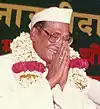| Chief Minister of Haryana | |
|---|---|
| हरियाणा के मुख्यमंत्री | |
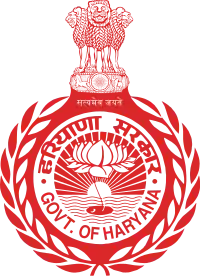 | |
| Style | The Honourable (Formal) Mr. Chief Minister (Informal) |
| Status | Head of Government |
| Abbreviation | CM |
| Member of | Haryana Legislative Assembly |
| Reports to | Governor of Haryana |
| Residence | 1, Sector 3, Chandigarh |
| Seat | Chandigarh |
| Appointer | Governor of Haryana |
| Term length | At the confidence of the assembly Chief minister's term is for five years and is subject to no term limits.[1] |
| Precursor | Chief Minister of Punjab |
| Inaugural holder | Bhagwat Dayal Sharma |
| Formation | 1 November 1966 |
| Deputy | Deputy Chief Minister |
| Salary |
|
| Website | Office of the Chief Minister |
The Chief Minister of Haryana (CMO Haryana) is the chief executive of the Indian state of Haryana. As per the Constitution of India, the governor is a state's de jure head, but de facto executive authority rests with the chief minister. Following elections to the Haryana Legislative Assembly, the state's governor usually invites the party (or coalition) with a majority of seats to form the government. The governor appoints the chief minister, whose council of ministers are collectively responsible to the assembly. Given that he has the confidence of the assembly, the chief minister's term is for five years and is subject to no term limits.[1] Since 1966, ten people have served as the chief minister of Haryana. The first was B. D. Sharma of the Indian National Congress party. Bhajan Lal Bishnoi is Haryana's longest-serving chief minister; he held office for 11 years 10 Months (4317 Days), Bansi Lal held office for 4268 Days. Devi Lal the fifth chief minister of Haryana, went on to twice serve as Deputy Prime Minister of India under prime ministers V. P. Singh and Chandra Shekhar. Om Prakash Chautala has served the most discontinuous stints as Chief Minister (four), as a member of three parties.
The incumbent chief minister is Manohar Lal Khattar, the first officeholder from the BJP, who was sworn in on 26 October 2014.
Chief ministers of Haryana
| No | Portrait | Name | Constituency | Term of office[2] | Assembly (Elections) |
Party[lower-alpha 1] | |||
|---|---|---|---|---|---|---|---|---|---|
| 1 | 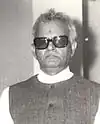
| Bhagwat Dayal Sharma | Jhajjar | 1 November 1966 | 23 March 1967 | 142 days | 1st | Indian National Congress | |
| 2nd | |||||||||
| 2 |  |
Rao Birender Singh | Pataudi | 24 March 1967 | 20 November 1967 | 241 days | Vishal Haryana Party | ||
| – | 
| Vacant[lower-alpha 2] (President's rule) | N/A | 20 November 1967 | 21 May 1968 | 183 days | Dissolved | N/A | |
| 3 |
|
Bansi Lal | Tosham | 21 May 1968 | 14 March 1972 | 7 years, 193 days | 3rd | Indian National Congress | |
| 14 March 1972 | 30 November 1975 | 4th | |||||||
| 4 |
|
Banarsi Das Gupta | Bhiwani | 1 December 1975 | 30 April 1977 | 1 year, 150 days | |||
| – | 
| Vacant[lower-alpha 2] (President's rule) | N/A | 30 April 1977 | 21 June 1977 | 52 days | Dissolved | N/A | |
| 5 | 
| Devi Lal | Bhattu Kalan | 21 June 1977 | 28 June 1979 | 2 years, 7 days | 5th | Janata Party | |
| 6 | .jpg.webp) |
Bhajan Lal | Adampur | 28 June 1979 | 23 May 1982 | 6 years, 341 days | |||
| 23 May 1982 | 4 June 1986 | 6th | Indian National Congress | ||||||
| (3) |
|
Bansi Lal | Tosham | 5 June 1986 | 20 June 1987 | 1 year, 15 days | |||
| (5) | 
| Devi Lal | Meham | 20 June 1987 | 2 December 1989 | 2 years, 165 days | 7th | Janata Dal | |
| 7 | 
| Om Prakash Chautala | Uchana Kalan | 2 December 1989 | 22 May 1990 | 171 days | |||
| (4) |
|
Banarsi Das Gupta | Bhiwani | 22 May 1990 | 12 July 1990 | 51 days | |||
| (7) | 
| Om Prakash Chautala | Uchana Kalan | 12 July 1990 | 17 July 1990 | 5 days | |||
| 8 | Hukam Singh | Dadri | 17 July 1990 | 22 March 1991 | 248 days | ||||
| (7) | 
| Om Prakash Chautala | Uchana Kalan | 22 March 1991 | 5 April 1991 | 14 days | Samajwadi Janta Party (Rashtriya) | ||
| – | 
| Vacant[lower-alpha 2] (President's rule) | N/A | 6 April 1991 | 23 July 1991 | 108 days | Dissolved | N/A | |
| (6) | .jpg.webp) |
Bhajan Lal | Adampur | 23 June 1991 | 10 May 1996 | 4 years, 322 days | 8th | Indian National Congress | |
| (3) |
|
Bansi Lal | Tosham | 11 May 1996 | 24 July 1999 | 3 years, 74 days | 9th | Haryana Vikas Party | |
| (7) | 
| Om Prakash Chautala | Narwana | 24 July 1999 | 2 March 2000 | 5 years, 224 days | Indian National Lok Dal | ||
| 2 March 2000 | 5 March 2005 | 10th | |||||||
| 9 | 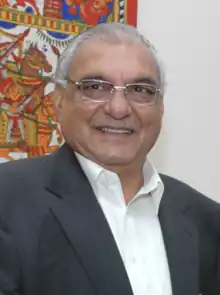
| Bhupinder Singh Hooda | Kiloi | 5 March 2005 | 25 October 2009 | 9 years, 235 days | 11th | Indian National Congress | |
| 25 October 2009 | 26 October 2014 | 12th | |||||||
| 10 | 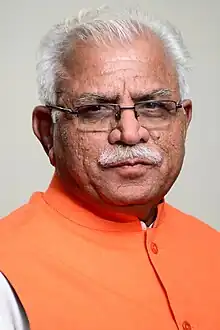
| Manohar Lal Khattar | Karnal | 26 October 2014 | 27 October 2019 | 9 years, 79 days | 13th | Bharatiya Janata Party | |
| 27 October 2019 | Incumbent | 14th | |||||||
Timeline

Notes
- Footnotes
- ↑ This column only names the chief minister's party. The state government he headed may have been a complex coalition of several parties and independents; these are not listed here.
- 1 2 3 President's rule may be imposed when the "government in a state is not able to function as per the Constitution", which often happens because no party or coalition has a majority in the assembly. When President's rule is in force in a state, its council of ministers stands dissolved. The office of chief minister thus lies vacant, and the administration is taken over by the governor, who functions on behalf of the central government. At times, the legislative assembly also stands dissolved.[3]
- References
- 1 2 Durga Das Basu. Introduction to the Constitution of India. 1960. 20th Edition, 2011 Reprint. pp. 241, 245. LexisNexis Butterworths Wadhwa Nagpur. ISBN 978-81-8038-559-9. Note: although the text talks about Indian state governments in general, it applies for the specific case of Uttar Pradesh as well.
- ↑ "No". Archived from the original on 13 May 2017. Retrieved 8 May 2014.
- ↑ Amberish K. Diwanji. "A dummy's guide to President's rule". Rediff.com. 15 March 2005.

